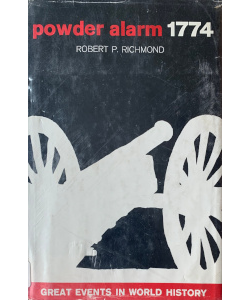Powder Alarm 1774

Author:
Robert P. Richmond
Cover Artist:
Saul Lambert
Illustrated with sketches, historical documents, and prints
Publication:
1971 by Auerbach
Simultaneously published by:
Book Center, Inc
Genre:
History, Non-fiction
Pages:
118
Current state:
Basic information has been added for this book.
It is under consideration and will be updated when it is evaluated further.
Book Guide
Search for this book used on:
In late 1774, British General Thomas Gage ordered the predawn removal of powder from the Charlestown storehouse in the Massachusetts Bay Colony, which signaled the end of conciliation between the colonists and the occupying British troops. This seizure of powder for "safekeeping" alarmed patriots as far away as New York and New Jersey. Fiery Colonel Israel Putnam of Connecticut, a courageous Indian fighter, began raising an army of 40,000 volunteers. Wiser strategists, however, were quick to cool his ardor.
"Not yet," one argued. "We are not yet ripe for armed conflict with the British regulars. Cool down and have an eye to your stocks of gunpowder."
Villages and towns throughout the colonies stepped up their secretive storage of powder and musket balls. The mood among the colonists changed and attitudes stiffened against the British troops as acts of Parliament imposed further restrictions on their rights and liberties. The Suffolk Resolves, boldly endorsed by the First Continental Congress, declared what was on the minds of America's patriots, "that force would be used, if necessary, to prevent enslavement of America."
In POWDER ALARM—1774, author Robert P. Richmond re-creates General Gage's move against the Charlestown powderhouse and examines its immediate and long range effects. With the help of information gleaned from official documents and eye-witness accounts, he shows how the powder alarm prepared the colonists for their first, big step toward independence and how the Battle of Bunker Hill was merely a logical extension of the colonists' mood.
From the dust jacket
To view an example page please sign in.
Content Guide
Please sign in to access all of the topics associated with this book and view other books with the same topics.
Please sign in to access the locations this book takes place in and view other books in the same location.
Please sign in to access the time periods this book takes place in and view other books in the same time period.
Please sign in to access information about the content of this book that you may want to consider before reading.
Find This Book
Search for this book used on:


